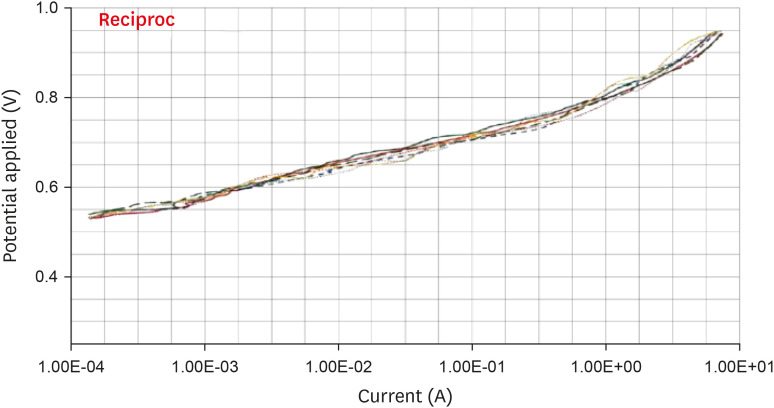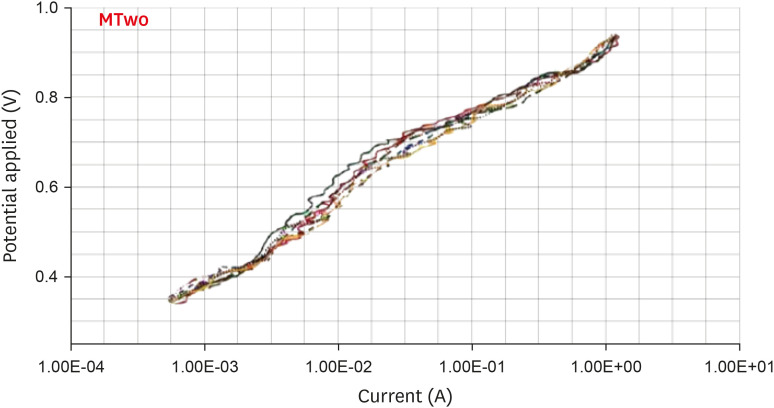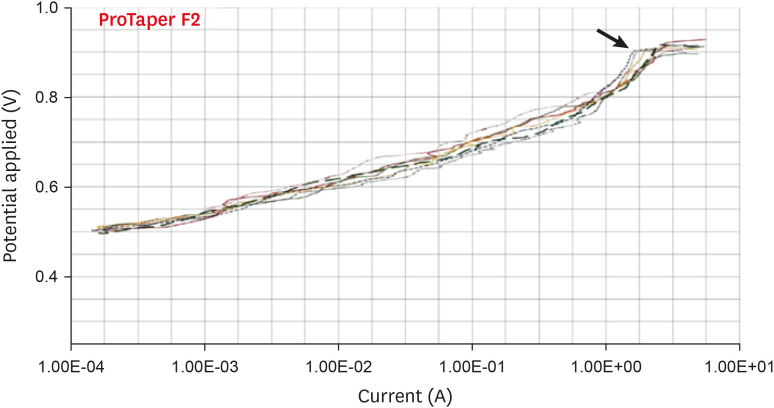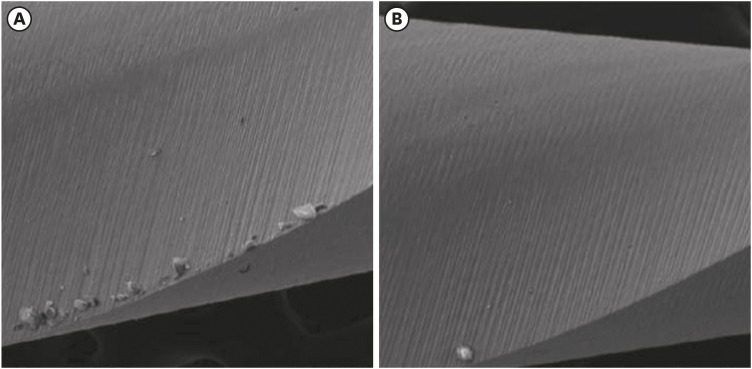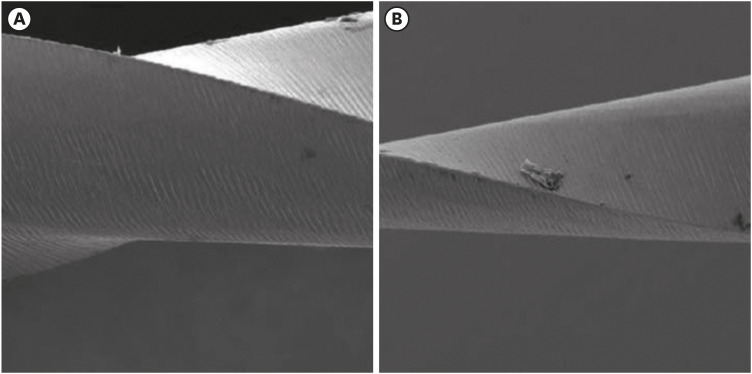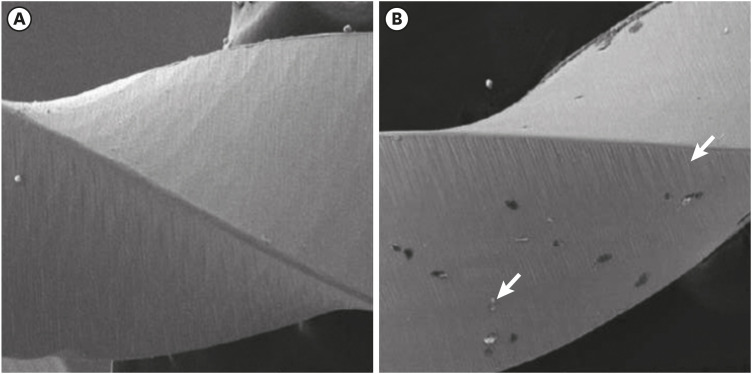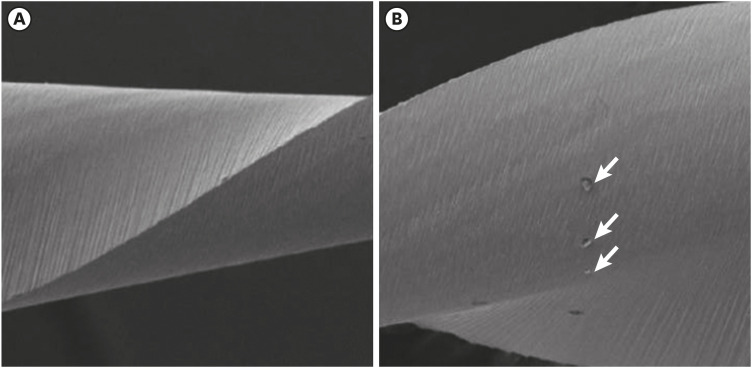Restor Dent Endod.
2021 Feb;46(1):e6. 10.5395/rde.2021.46.e6.
Corrosion resistance assessment of nickel-titanium endodontic files with and without heat treatment
- Affiliations
-
- 1Department of Endodontics, Juiz de Fora Estacio University Center, Juiz de Fora, MG, Brazil
- 2Department of Metallurgical Engineering, Federal Institute Juiz de Fora, Juiz de Fora, MG, Brazil
- 3Department of Orthodontics, Federal University of Juiz de Fora, Juiz de Fora, MG, Brazil
- 4Department of Endodontics, Federal University of Juiz de Fora, Juiz de Fora, MG, Brazil
- KMID: 2548056
- DOI: http://doi.org/10.5395/rde.2021.46.e6
Abstract
Objectives
The aim of this study was to evaluate the corrosion resistance of heat-treated (Reciproc and WaveOne) and non-heat-treated (ProTaper and Mtwo) superelastic nickeltitanium endodontic files when immersed in a 5.25% sodium hypochlorite solution.
Materials and Methods
Anodic polarization curves were obtained with potential sweeps that began at the open circuit potential or corrosion potential (Ecorr ). The pitting potential (Epit ) was identified on the anodic polarization curve as the potential at which a sudden increase in current was observed. The micromorphology of the 28 tested files was analyzed before and after the electrochemical assay using scanning electron microscope (SEM). The data were analyzed using 1-way analysis of variance with the post hoc Bonferroni test (for Ecorr ) and the Student t-test for independent samples (for Epit ).
Results
The mean Ecorr values were 0.506 V for ProTaper, 0.348 V for Mtwo, 0.542 V for Reciproc, and 0.321 V for WaveOne files. Only WaveOne and Protaper files exhibited pitting corrosion, with Epit values of 0.879 V and 0.904 V, respectively. On the SEM images of the ProTaper and WaveOne files, cavities suggestive of pitting corrosion were detected.
Conclusions
Signs of corrosion were observed in both heat-treated and non-heat-treated files. Of the evaluated files, WaveOne (a heat-treated file) and ProTaper (a non-heat-treated file) exhibited the lowest corrosion resistance.
Keyword
Figure
Reference
-
1. Walia HM, Brantley WA, Gerstein H. An initial investigation of the bending and torsional properties of Nitinol root canal files. J Endod. 1988; 14:346–351. PMID: 3251996.
Article2. Gavini G, Santos MD, Caldeira CL, Machado MEL, Freire LG, Iglecias EF, Peters OA, Candeiro GTM. Nickel-titanium instruments in endodontics: a concise review of the state of the art. Braz Oral Res. 2018; 32:e67. PMID: 30365608.
Article3. Hilt BR, Cunningham CJ, Shen C, Richards N. Torsional properties of stainless-steel and nickel-titanium files after multiple autoclave sterilizations. J Endod. 2000; 26:76–80. PMID: 11194376.
Article4. Darabara M, Bourithis L, Zinelis S, Papadimitriou GD. Susceptibility to localized corrosion of stainless steel and NiTi endodontic instruments in irrigating solutions. Int Endod J. 2004; 37:705–710. PMID: 15347296.
Article5. Talha M, Behera CK, Sinha OP. A review on nickel-free nitrogen containing austenitic stainless steels for biomedical applications. Mater Sci Eng C. 2013; 33:3563–3575.
Article6. Wright PP, Kahler B, Walsh LJ. Alkaline sodium hypochlorite irrigant and its chemical interactions. Materials (Basel). 2017; 10:1147–1155.
Article7. Pedullà E, Benites A, La Rosa GM, Plotino G, Grande NM, Rapisarda E, Generali L. Cyclic fatigue resistance of heat-treated nickel-titanium instruments after immersion in sodium hypochlorite and/or sterilization. J Endod. 2018; 44:648–653. PMID: 29397218.
Article8. Ametrano G, D'Antò V, Di Caprio MP, Simeone M, Rengo S, Spagnuolo G. Effects of sodium hypochlorite and ethylenediaminetetraacetic acid on rotary nickel-titanium instruments evaluated using atomic force microscopy. Int Endod J. 2011; 44:203–209. PMID: 20880135.
Article9. Bonaccorso A, Tripi TR, Rondelli G, Condorelli GG, Cantatore G, Schäfer E. Pitting corrosion resistance of nickel-titanium rotary instruments with different surface treatments in seventeen percent ethylenediaminetetraacetic acid and sodium chloride solutions. J Endod. 2008; 34:208–211. PMID: 18215684.
Article10. Lee JB, Yoon SI. Effect of nitrogen alloying on the semiconducting properties of passive films and metastable pitting susceptibility of 316L and 316LN stainless steels. Mater Chem Phys. 2010; 122:194–199.
Article11. Prymak O, Klocke A, Kahl-Nieke B, Epple M. Fatigue of orthodontic nickel-titanium (NiTi) wires in different fluids under constant mechanical stress. Mater Sci Eng A. 2004; 378:110–114.
Article12. Stokes OW, Fiore PM, Barss JT, Koerber A, Gilbert JL, Lautenschlager EP. Corrosion in stainless-steel and nickel-titanium files. J Endod. 1999; 25:17–20. PMID: 10196837.
Article13. Yum JW, Park JK, Hur B, Kim HC. Comparative analysis of various corrosive environmental conditions for NiTi rotary files. J Korean Acad Conserv Dent. 2008; 33:377–388.
Article14. Berutti E, Angelini E, Rigolone M, Migliaretti G, Pasqualini D. Influence of sodium hypochlorite on fracture properties and corrosion of ProTaper Rotary instruments. Int Endod J. 2006; 39:693–699. PMID: 16916358.
Article15. Pereira ES, Peixoto IF, Viana AC, Oliveira II, Gonzalez BM, Buono VT, Bahia MG. Physical and mechanical properties of a thermomechanically treated NiTi wire used in the manufacture of rotary endodontic instruments. Int Endod J. 2012; 45:469–474. PMID: 22188417.
Article16. Ye J, Gao Y. Metallurgical characterization of M-Wire nickel-titanium shape memory alloy used for endodontic rotary instruments during low-cycle fatigue. J Endod. 2012; 38:105–107. PMID: 22152631.
Article17. Aoun CM, Nehme WB, Naaman AS, Khalil IT. Review and classification of heat treatment procedures and their impact on mechanical behavior of endodontic files. Int J Curr Res. 2017; 9:51300–51306.18. Gutmann JL, Gao Y. Alteration in the inherent metallic and surface properties of nickel-titanium root canal instruments to enhance performance, durability and safety: a focused review. Int Endod J. 2012; 45:113–128. PMID: 21902705.
Article19. Prasad PS, Sam JE, Kumar A, Kannan . The effect of 5% sodium hypochlorite, 17% EDTA and triphala on two different rotary Ni-Ti instruments: an AFM and EDS analysis. J Conserv Dent. 2014; 17:462–466. PMID: 25298649.
Article20. Ramires I, Guastaldi AC. Study of Ti-6Al-4V biomaterial using electrochemistry and XPS techniques. Quim Nova. 2002; 25:10–14.21. Olmedo DG, Tasat DR, Duffó G, Guglielmotti MB, Cabrini RL. The issue of corrosion in dental implants: a review. Acta Odontol Latinoam. 2009; 22:3–9. PMID: 19601489.22. Silva EF, Oliveira LF. Chemical and metallographic characterization of stainless steel in implants removed from patients. Acta Ortop Bras. 2011; 19:280–285.23. Sonntag RE, Gordon JV. Introduction to thermodynamics: classical and statistical. 3rd ed. Hoboken, NJ: John Wiley & Sons, Inc;1991. p. 800.24. Lambert FL. Configurational entropy revisited. J Chem Educ. 2007; 84:1548–1550.
Article
- Full Text Links
- Actions
-
Cited
- CITED
-
- Close
- Share
- Similar articles
-
- The effect of NaOCl treatment and sterilization procedures on the corrosion of endodontic files
- Cyclic fatigue of the sodium hypochlorite treated and/or steam autoclaved nickel-titanium endodontic files
- Effects of heat treatment on the load-deflection properties of nickel-titanium wire
- Cyclic fatigue resistance of the WaveOne Gold Glider, ProGlider, and the One G glide path instruments in double-curvature canals
- Effect of adaptive motion on cyclic fatigue resistance of a nickel titanium instrument designed for retreatment


